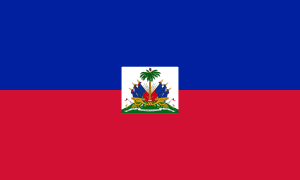
| Colors | HEX Code | RGB | CMYK |
|---|---|---|---|
| Blue | #00209F | 0, 32, 159 | 100, 80, 0, 38 |
| Red | #D21034 | 210, 16, 52 | 0, 92, 75, 18 |
| White | #FFFFFF | 255, 255, 255 | 0, 0, 0, 0 |
| Green | #016916 | 1, 105, 22 | 99, 0, 79, 59 |
| Gold | #EFB417 | 239, 180, 23 | 0, 25, 90, 6 |
The flag of Haiti has two horizontal equal stripes colored blue and red respectively. In the center of the flag there is a white square on which the coat of arms of Haiti is featured. The coat of arms includes a palm tree surmounted by the liberty cap. On each side of the palm tree, there are three flags, making six flags in all, six rifles, and two cannons on a green lawn. On the green lawn, there are also several items: a drum, bugles, cannonballs, and ship anchors. At the bottom of the green lawn there is the legendary motto “In Union there is Strength” which is transcribed in French as follows: L’Union Fait la Force.
Meaning of the Haiti Flag
The blue color represents liberty and the black citizens of Haiti. Red symbolizes the blood shed by Haitians during their struggle for independence from French colonial rule. The white color represents purity. The coat of arms stands for independence and liberty.
History of the Haiti Flag
Haiti was a French colony when the French Revolution took place in 1789. Inspired by the French Revolution, the Haitians revolted against slavery in 1791. During French rule, the Haitians raised the French flag from which the white stripe was removed later in 1803. The Haitian flag experienced eight more changes between 1804 and 1986, including the change of the blue stripe into black in the 1850s by Emperor Faustin-Élie Soulouque which was changed again to blue after he was thrown from power. The black stripe was introduced again by the ruler Francois Duvalier in 1964. The current version of the flag was adopted in 1986.